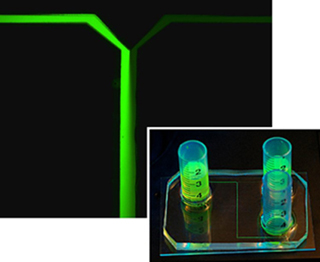
Microfluidic, laminar flow chamber (lower right). Fluids flow from the top two reservoirs, combine, and mix by diffusion as they flow along the center channel. The upper left image is a magnified view showing diffusion where the two fluids meet. (Image courtesy of Carlos Dorta-Quinones and Noel Reyes-Gonzalez. Used with permission.)
Instructor(s)
Prof. Dennis Freeman
MIT Course Number
6.021J / 2.791J / 2.794J / 6.521J / 20.370J / 20.470J / HST.541J
As Taught In
Fall 2004
Level
Undergraduate
Course Description
Course Features
Course Description
In this subject, we consider two basic topics in cellular biophysics, posed here as questions:
- Which molecules are transported across cellular membranes, and what are the mechanisms of transport? How do cells maintain their compositions, volume, and membrane potential?
- How are potentials generated across the membranes of cells? What do these potentials do?
Although the questions posed are fundamentally biological questions, the methods for answering these questions are inherently multidisciplinary. As we will see throughout the course, the role of mathematical models is to express concepts precisely enough that precise conclusions can be drawn. In connection with all the topics covered, we will consider both theory and experiment. For the student, the educational value of examining the interplay between theory and experiment transcends the value of the specific knowledge gained in the subject matter.
This course is jointly offered through four departments, available to both undergraduates and graduates.


